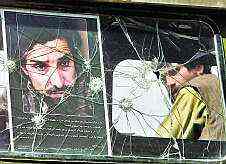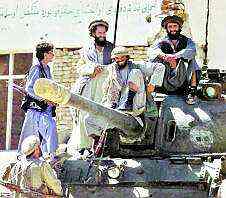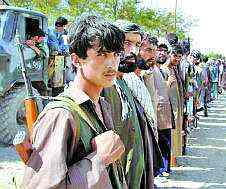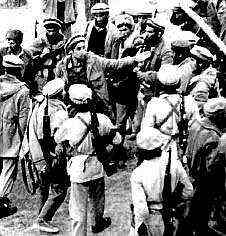Toronto Star
http://www.thestar.com/
Unholy alliance
West's new allies include vitriolic
anti-Americans, human-rights violators, former allies of Osama bin
Laden and more ...
Thomas Walkom
STAFF REPORTER
 MIKHAIL METZEL/AP PHOTO
MIKHAIL METZEL/AP PHOTO
FALLEN LEADER: A portrait of
assassinated Northern Alliance leader Ahmed Shah Massood looks
out from bullet-shattered windshield

MIKHAIL METZEL/AP
PHOTO
NORTHERN ALLIANCE: U.S
officials are hinting they'll provide weapons to the estimated
15,000 troops of the alliance.

MIKHAIL METZEL/AP
PHOTO
THE WEST'S NEW ALLIES:
Northern Alliance troops form ranks at a former Soviet army
air force base at Baghram.

MIKHAIL METZEL/AP
PHOTO
EARLY DAYS: Ahmed Shah
Massood gestures with outstretched arm as he rallies his
followers at Rokkeh, north of Kabul.
|
THE WEST'S new Afghan friends in the war against
terrorism and the Taliban are a curious lot. They include Islamic
fundamentalists, vitriolic anti-Americans, human-rights violators,
one-time allies of Osama bin Laden and soldiers of the former
communist regime.
Officially, they are known as the United Islamic Front for
the Salvation of Afghanistan. Unofficially, they call themselves the
Northern Alliance.
The terror attacks on the United States have given them a
boost in their five-year-old war against the Taliban, the hard-line
Islamic regime that rules almost all of Afghanistan.
Already, U.S officials are hinting they'll provide weapons to
the alliance's estimated 15,000 troops, on top of the non-military
aid Washington has been giving since 1998.
Western journalists, too, have rediscovered the alliance and
are busy reporting on what some are already calling Afghanistan's
new freedom fighters.
But the history of the key players in the Northern Alliance
suggests they may prove difficult allies in the U.S.-led war against
terror. An uneasy coalition, bound as much by mutual hatred as by
dislike of the ruling Taliban, their relations with one another over
the past decade have been marked by treachery, backstabbing and a
level of deviousness so profound that the word Byzantine cannot do
it justice.
"They may not be perfect," acknowledges Mike Vickers, a
former officer with the U.S. Central Intelligence Agency and now
director of strategic studies for the Washington-based Center for
Strategic and Budgeting Assessments. "But the Northern Alliance does
have some good elements."
At times, those good elements are hard to find.
Senior members of the alliance, including former Afghan
president Burhanuddin Rabbani and northern warlord Abdul Rashid
Dostum, a key ally of the Soviet Union during that country's attempt
to occupy Afghanistan, have been cited by the U.S. for human-rights
abuses.
Deputy-premier Abdul Rasul Sayyaf, the alliance's number two
political figure, is a hard-line, vehemently anti-American Islamic
fundamentalist who is so strict on the subject of separation of the
sexes that, according to one Associated Press report, he won't even
speak to women.
Yet another figure in the alliance, eastern warlord Haji
Abdul Qadir, was Osama bin Laden's first sponsor in Afghanistan when
the Saudi millionaire � already wanted at the time by the U.S. for
his alleged involvement in anti-American terrorist attacks � fled to
that country in 1996. At different times, both Rabbani and Dostum
have found themselves in informal alliances with the Taliban and
occasionally against each other.
At other times, the various factions have cheerfully
massacred one another. In 1993, according to the non-governmental
organization, Human Rights Watch, Rabbani's Society of Islam killed
70 to 100 members of the Hazara minority linked to the rival Party
of Islamic Unity, another member of the Northern Alliance.
Two years later, according to the U.S. State Department,
Rabbani forces � under the command of Ahmed Shah Massood (celebrated
by Western journalists as the "Lion of the Panjshir" until his
untimely assassination last month) � went on another anti-Hazara
rampage "systematically looting whole streets and raping women."
As for the shifting loyalties of the Northern Alliance
members, these are so numerous as to make the head ache.
In 1994, Rabbani's Society of Islam was informally allied to
the Taliban in an effort to defeat the rival Party of Islam of
Gulbuddin Hekmatyar, an Islamic fundamentalist who, during the
decade-long war against the Soviet Union, had been sponsored by the
CIA.
A year later, Rabbani and Hekmatyar allied with each other to
fight the Taliban.
And now Hekmatyar, in exile in Iran, is opposed to both
Rabbani and the Taliban.
Dostum's career is even more complicated. From 1979 to 1992,
he was allied with the communist government in Kabul. As that
government was about to fall, Dostum switched loyalties to join the
anti-communist mujahideen "freedom fighters."
When the various mujahideen factions had a falling
out, he first allied himself with Rabbani to fight Hekmatyar. Later,
he joined Hekmatyar to fight Rabbani.
By 1995, he was supporting the Taliban against both Hekmatyar
and Rabbani. By 1996, he was allied with his two former enemies
against the Taliban.
Up to now, the U.S. and other Western countries have kept a
respectable distance from the Northern Alliance.
The United Nations recognizes Rabbani's Islamic State of
Afghanistan as the legitimate government of the country. But except
for India, Iran, Russia and a few Central Asian states, almost no
one else does.
Neither Canada nor the U.S. has recognized any government in
Afghanistan since 1979.
Then, there is the drug question. Until last year, about
three-quarters of the world's heroin came from Afghanistan. Both the
Taliban and the Northern Alliance used profits from opium production
and drug smuggling to finance their war against each another.
Last July, in a move to win acceptance from the U.S., the
Taliban banned opium production in the 95 per cent of Afghanistan it
controls. While the U.S. was initially skeptical, it finally
acknowledged this year that the Taliban proscription was working.
Much to the embarrassment of those who would support
Rabbani's forces, however, the Northern Alliance merrily continues
in the heroin trade.
According to the U.S. State Department, virtually the entire
Afghan opium crop this year � about 77 tonnes � was grown in
territories controlled by the alliance. Russian media report that
the heroin manufactured from that opium is smuggled to Europe and
America through neighbouring states such as Tajikistan.
To the outsider, the convoluted interrelations of the
Northern Alliance might seem pure pathology.
But those who know Afghanistan say the alliance's history �
and indeed the history of the Taliban � can be understood only in
light of the country's tribal, ethnic and social divisions.
Afghanistan is a melange of peoples. The largest group, the
Pashtun, who inhabit the southern parts of the country near
Pakistan, are thought to comprise anywhere from 40 to 60 per cent of
the population.
Tajiks, who tend to live in the northeast, form the next
largest group. Smaller minorities include the Hazara of the west
(roughly 15 to 20 per cent) and the Uzbeks of the northwest.
Unlike most Afghanis (who are Sunni Muslims), the Hazara tend
to be Shi'ite, with links to Iran. Traditionally, the Hazara have
also faced more discrimination than the other groups.
For more than 100 years, a Pashtun clan, the Muhammadzai,
dominated the country and provided the kings, including the current
exiled monarch, Mohammed Zahir Shah.
The Muhammadzai also provided the governing elite, which made
efforts, often bitterly opposed by religious conservatives, to make
Afghanistan more closely resemble the West.
(In 1926, one king who tried to follow Turkey's lead by
requiring women to give up the
burqa, or head-to-toe veil,
was forced to flee the country).
"The government in Afghanistan was like a club for the
Muhammadzais," noted Barnett Rubin, an expert on the region and head
of New York University's Center on International Co-operation, in an
interview with the U.S.-based Asia Society this year.
"This is why so many other newly educated elites who were not
Muhammadzais resented them and became Islamists or radical
nationalists or communists or Maoists."
Meanwhile, in the countryside, local tribal leaders and, to a
lesser extent, local religious leaders remained powerful.
Tensions finally came to a head in 1973. The king was deposed
by his cousin, Mohammed Daoud, who proclaimed a republic and began �
with the help of the U.S. and the Soviet Union � to accelerate the
pace of reform.
Daoud's move met instant opposition. Islamists � including
Rabbani, Hekmatyar and Massood � fled to Pakistan to plot against
the regime.
Pakistani authorities, alarmed by Daoud's support for carving
out an independent Pashtun state in their country, eagerly welcomed
the Islamist dissidents.
Meanwhile, in Afghanistan, other anti-Daoud forces, including
many in the military, coalesced around what was, in effect, the
Communist party.
In 1978, the more radical wing of the communists seized power
in a military coup. Their ambitious social and land reform plans, as
well as their murderous repression of political enemies, sent the
country spiralling into chaos.
A year later, the Soviets invaded and installed in power the
more moderate, pro-Moscow wing of the Communist party. That only
worsened the crisis. It also brought the U.S. into the fray as chief
sponsor of the anti-Soviet
mujahideen.
Whatever peace had existed among the country's competing
groups evaporated during the bitter 10-year war.
Nominally, the
mujahideen were all friends. In fact,
there was constant friction. Rabbani and Massood were Tajiks.
Hekmatyar and his forces were Pashtun. Hazaras gravitated
towards the Shi'ite Party of Islamic Unity, now controlled by Karim
Khalili.
In the northwest, the country's Uzbek minority under Dostum
made peace with the Soviets and war on the
mujahideen.
Not only were the Uzbeks different ethnically, they also were
less militantly Islamic. (Dostum himself drove an armoured Cadillac
and vowed he would never bow to those who banned whiskey).
The Soviets withdrew in 1989 and the communist government
fell in 1992. It was at this point that the pent-up ethnic, regional
and religious tensions spilled into view.
At one level, the complex series of alliances and betrayals
among the
mujahideen factions, the Taliban and Dostum's
Uzbeks that characterize the past nine years boiled down to simple
turf protection.
Each faction had its own base. The point was to oppose anyone
who threatened it. For each faction, today's ally could always be
tomorrow's enemy.
Vickers, the former CIA agent, acknowledges the difficulty of
backing a Northern Alliance that isn't really an alliance.
But, he says, the U.S. doesn't have much choice.
"The Taliban is the central objective here. Air power won't
deal with them. We will need ground forces.
"The question is: Whose ground forces? That's why the
opposition looks attractive ....
"They may not be perfect. But the question is: Is it better
to use them or to use Western ground troops?"
Ultimately, however, Vickers and other analysts say the
problem the U.S. faces is political.
To Afghanistan's biggest ethnic group, the Pashtun, the
Northern Alliance is a melange of old tribal enemies.
"It's not that they (the alliance) are horrible," says
Vickers." You don't have to demonize them to see that (without a
Pashtun component) it won't work."
Presumably, this is what the deposed king is supposed to
offer: Mohammed Zahir Shah is Pashtun.
But the 86-year-old ex-monarch has been away from the action
for 28 years and, as Vickers points out, the king's Muhammadzai clan
was "not great to the minorities."
Still, there appears to be no other anti-Taliban Pashtun
leader on the scene who is even remotely credible.
Would Afghanistan be better off with the Taliban replaced by
the alliance?
Vickers, expressing the common wisdom, says it couldn't be
worse.
But others point out that the position of women, for
instance, is not expected to improve greatly under a Northern
Alliance government.
They note that Sayyaf, in particular, tried to introduce his
rigorous brand of Islamic law to the parts of Afghanistan he and
Rabbani controlled well before the Taliban became a force.
In 1992, for instance, when Rabbani, Sayyaf, Massood and
other
mujahideen finally captured the country's cosmopolitan
capital, Kabul, one of their first acts was to ban the use of female
newsreaders on television.
Two years later, and still before the Taliban took Kabul, the
United Nations reported that women in the capital were being told to
quit their jobs and wear the full-length
burqa.
Women who didn't comply were liable to be raped by members of
the various
mujahideen militias that prowled the city.
Ironically, Afghan women did better � in Western terms �
under the communist government that the West so vehemently opposed.
Still, as far as the war against terrorism goes, the welfare of
Afghanistan is seen as secondary.
The point is to get bin Laden.
"I don't want more civil war," says Vickers. "But I suppose
even chaos is better than what we have."
Further Reading:
F.�.W.�. Magazine || 9/11: The Archive - The 'Lighter' Side of the New World Order?








